Physical Address
304 North Cardinal St.
Dorchester Center, MA 02124
Musculoskeletal disorders are a common source of pain and disability globally and are ubiquitous in industrialized nations; among them, low back pain (LBP) is the most common. Second only to respiratory tract infections, LBP is the most frequent reason for outpatient doctor visits and, as it often affects the young and the employed, is the most common cause of work related disability. The rising expenditures of LBP, both the direct costs of care and the indirect costs of disability and lost productivity, amount to billions of dollars each year in the United States alone. The reported lifetime incidence of LBP is highly variable, ranging from 13.8% to 31%. This discrepancy is likely because of the poorly defined and heterogeneous causes of LBP. The conditions causing LBP are protean, and the pain can originate not only from the various spinal components and the neural structures housed within the spinal column but also from the surrounding muscles, tendons, and ligaments. Additionally, pain can be referred from the abdominal and pelvic viscera and the adjacent joints. Thus the list of structures causing LBP is extensive and includes the intervertebral discs (IVDs), vertebral bodies, facet joints, spinal nerve roots (NRs), the spinal and paraspinal soft tissues, and the sacroiliac and hip joints. This unwieldy list of possible etiologies of LBP can be initially managed by categorizing these conditions into two broad groups: a) conditions that, if untreated, can be life threatening or can cause serious neurologic injury and b) conditions that are benign and self-limiting and are unlikely to cause neural damage. The first group is typically comprised of fractures and dislocations of the spine, both primary and secondary; tumors and infections of the spinal and related neural structures; inflammatory conditions such as ankylosing spondylitis and rheumatoid arthritis; metabolic conditions such as Paget’s disease; and spinal deformities such as scoliosis and kyphosis. The second category of spinal pain generators consists of a wide range of benign and self-limiting conditions that includes lumbar sprain and strain, myofascial pain syndrome (MFPS), herniated disc (HD), lumbar spinal stenosis (LSS), degenerative disc disease (DDD), internal disc disruption (IDD), lumbar facet syndrome (LFS), sacroiliac joint dysfunction (SIJD), spondylolysis, spondylolisthesis, and spinal instability (SI). In this book, we discuss the causes of LBP pertinent to the practice of pain medicine. This specific chapter discusses conditions causing LBP that can be linked to the dysfunction of the IVDs (DD) and include HD, LSS, DDD, IDD, and LFS. Other significant causes of LBP, e.g. pain of muscular and ligamentous origin, MFPS, SIJD, and SI, though associated with DD, frequently occur independently and are discussed elsewhere in this textbook. Conditions that are life threatening or can cause serious neurologic compromise, that is, the first group, are generally ruled out prior to a referral to a pain medicine physician and are beyond the scope of this chapter. LBP frequently radiates to the lower extremities either in dermatomal (radicular pain) or non-dermatomal (referred pain) distribution, and a brief discussion of both categories will be presented.
Pain, paresthesia, and numbness in a dermatomal distribution and a positive straight-leg raise (SLR) test, with or without accompanying signs of sensory loss, weakness, and diminished reflexes, are mediated by sensory spinal NRs (SSNRs) or dorsal root ganglia (DRG). These symptoms of lumbar radicular syndrome (LRS) can be present in isolation. However, they are generally present in conjunction with LBP. The incidence of LRS in patients with LBP is reported to range from 12% to 40%. Other terms used for LRS include lumbar radiculopathy , which inappropriately implies the presence of objective signs of NR damage-loss of sensation, muscle weakness, and diminished reflexes; lumbar radiculitis, which incorrectly proposes that an inflammatory process is primarily responsible for the radicular signs and symptoms; and lumbar radicular pain , which mistakenly assumes that pain is always the principal symptom. Hence, the descriptive term LRS may be the most accurate as it correctly suggests a constellation of clinical signs and symptoms of variable etiology secondary to the pathology or dysfunction of the SSNRs or DRGs. The term sciatica is also often used synonymously with LRS. However, this term incorrectly implies that the level of injury is at the peripheral nerve rather than the SSNR or DRG. Because of convergence and overlap of somatosensory input at the spinal and supra-spinal levels, pain from the various low back pathologies, e.g. IDD, FJS, SIJD, can refer to the lower extremities without the involvement of SSNRs or DRGs. This pain is non-dermatomal in distribution and typically radiates to the buttocks and lateral thighs; it rarely radiates below the knee joints into the legs and feet.
LRS is caused when the impulses generated at the SSNR and DRG locations are perceived as pain, numbness, or tingling in areas innervated by the affected axons, i.e. in a dermatomal distribution ( Fig. 29.1 ). The pathologic processes causing LBP and LRS are similar, but there is obligatory involvement of SSNRs and DRG in LRS. Lesions in the IVD and spinal stenosis are the most common cause of LRS. Additionally, neoplastic, infectious, traumatic, metabolic, and vascular lesions discussed can also involve the SSNRs, DRGs, and the lumbosacral plexuses and can infrequently produce radicular signs and symptoms. The entrapment neuropathies involving the sciatic nerve (e.g. the piriformis muscle and the ischial tunnel syndromes) can also generate pain and paresthesia in the lower extremity. However, these typically affect multiple dermatomes. The somatic referred pain, because of interneuronal convergence within the spinal cord, in addition to being non-dermatomal in nature, has a deep aching quality and lacks the objective signs of NR involvement.
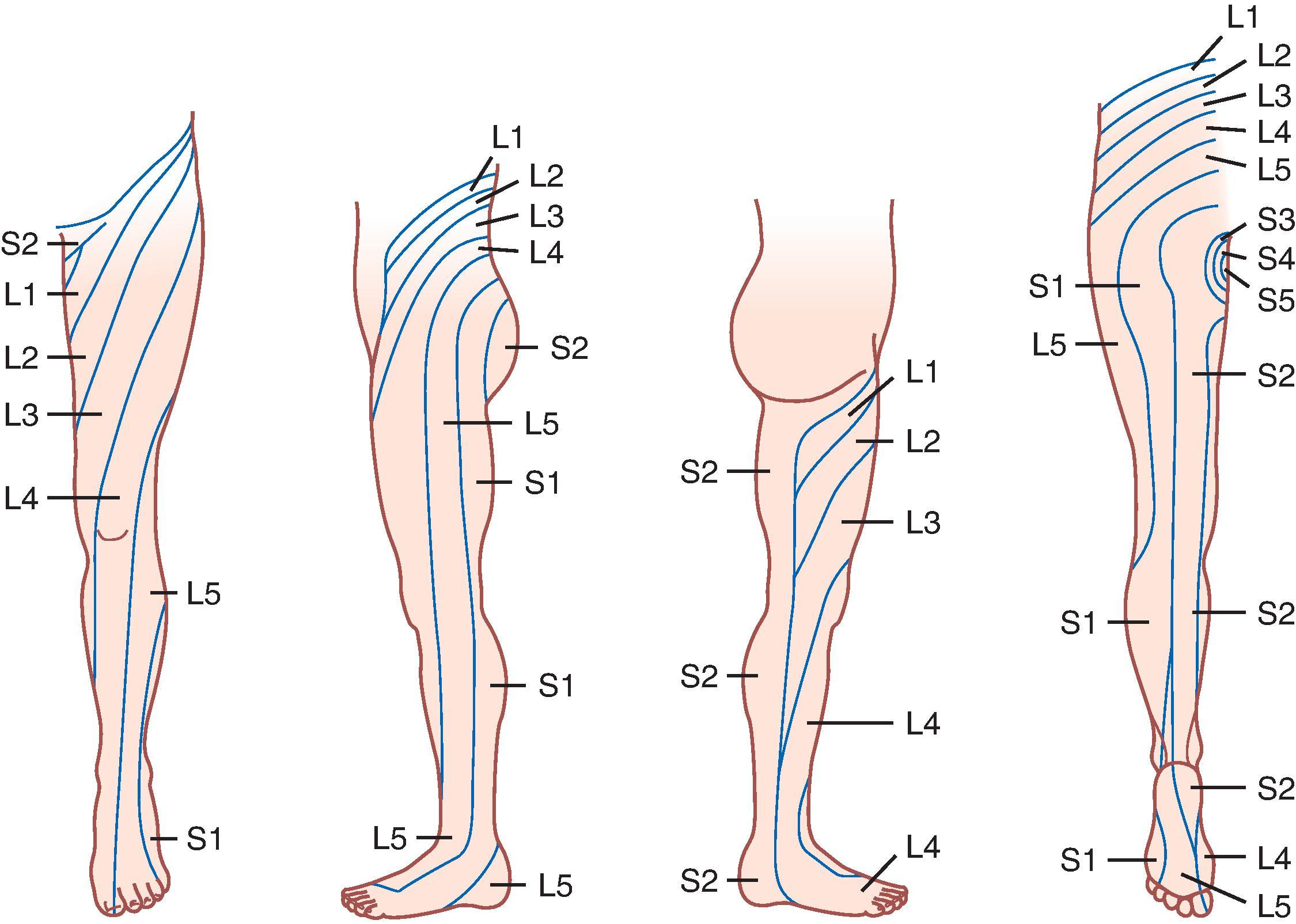
Though pain is the predominant symptom, other features of radicular involvement include paresthesia, numbness, and weakness in the distribution of the involved NR. Radicular pain typically travels along a narrow band and is of sharp, shooting, and lancinating quality. Objective signs include gait disturbances, loss of sensation, reduced muscle strength, and diminished reflexes involving the corresponding dermatome. HDs and the degenerative spinal conditions typically involve the lower lumbar NRs, whereas the more sinister causes of LRS, e.g. local tumor invasion, tend to involve more superior NRs with greater frequency. Characteristic features of the various lumbar and sacral NR involvement include:
S1: Pain, paresthesia, and numbness of the posterior part of the thigh, calf, and plantar surface of the foot, difficulty toe walking, weakness of plantar flexion, and loss of the plantar reflex.
L5: Pain, paresthesia, and numbness involving the buttock, anterolateral aspect of the leg, dorsal surface of the foot and great toe, difficulty heel walking (steppage gait), and weakness of ankle and toe extension.
L4: Pain, paresthesia, and numbness involving the anterior part of the thigh, knee, and upper medial portion of the leg, weakness of knee extension, and a diminished patellar tendon reflex.
L3 and L2: Pain, paresthesia, and numbness involving the groin and inner thigh areas, weakness in hip flexion.
Lower Sacral NRs: Decreased sensation in the buttock and perineal areas (i.e. saddle anesthesia) and autonomic dysfunction as indicated by bowel and bladder dysfunction (typically urinary retention and constipation followed by incontinence), and sexual dysfunction manifested as loss of erection in men and vaginal anesthesia in women. ,
Several tests can be performed to confirm the presence of NR irritation ( Box 29.1 ). Passive SLR test or Lasègue test assesses the presence of worsening pain in the radicular distribution with ankle dorsiflexion of the extended lower extremity, which results from the traction of lower lumbar NRs that are drawn caudally between 1.4 and 4 mm. Therefore a positive SLR suggests radicular pathology of the lower lumbar NRs (L4, L5, and S1). Radicular pain in the affected leg when the contralateral asymptomatic leg is similarly raised constitutes an X-SLR test. Although a positive SLR test is highly sensitive, X-SLR is more specific for lumbar NR irritation. An increase in back pain during SLR is typically attributed to NR movement in lumbar spinal segments, and a centrally HD can exclusively generate LBP with an SLR because of strain on the anterior theca. Tripod test confirms positive SLR test in a patient in sitting position—with the patient seated, the knee is extended and the foot dorsiflexed. During a femoral stretch test, the patient is in a prone position, the knee is flexed, and the hip extended; it places the L2 and L3 NRs under tension and indicates irritation of these NRs.
Straight-leg raise
Straight-leg raise and ankle dorsiflexion of the extended lower extremity
Crossed straight-leg raise
Tripod test
Femoral stretch test
Although radicular symptoms have been known since ancient times, they were first attributed to “posterior displacement of the disc” by Goldthwaite in 1911. The incidence of symptomatic HD is estimated to be 1% to 2% in the general population, for which approximately 200,000 lumbar discectomies are performed each year.
Disc herniation may be defined as the displacement of disc material beyond the confines of the IVD space ( Fig. 29.2 ). Although the nucleus pulposus (NP) is typically the principal component, other constituents (e.g. cartilage, bone, and disc annular tissue) also frequently comprise the HD material. The various terms used to describe disc herniation include herniated NP , ruptured disc , prolapsed disc . However, the term HD seems most appropriate as it conveys the concept of displacement of any disc component regardless of source. HD is further classified based on the morphology of the herniated material. A protruded disc is present when the neck (i.e. the distance between the edges of the base) of the herniated material is wider than the widest disc diameter in any given plane ( Fig. 29.3 ). Disc extrusion is the opposite of disc protrusion in that the neck is narrower than the widest disc diameter in any given plane ( Fig. 29.4 ). Disc sequestration is a type of disc extrusion whereby no continuity exists between the herniated material and the parent disc. HD is also classified based on the integrity of the overlying annulus fibrosus (AF). A contained herniation, in contrast to a non-contained herniation, is distinguished by the fact that the displaced disc material is covered by an intact annulus. Of note, the currently available diagnostic modalities, including computed tomography (CT), magnetic resonance imaging (MRI), and discography, are unable to accurately ascertain the integrity of the disc annulus, and these distinctions may be arbitrary. The terms desiccation , fibrosis , narrowing , bulging , fissuring , and sclerosis of the disc are also used. However, they suggest degenerative disc processes and do not reflect disc herniation.
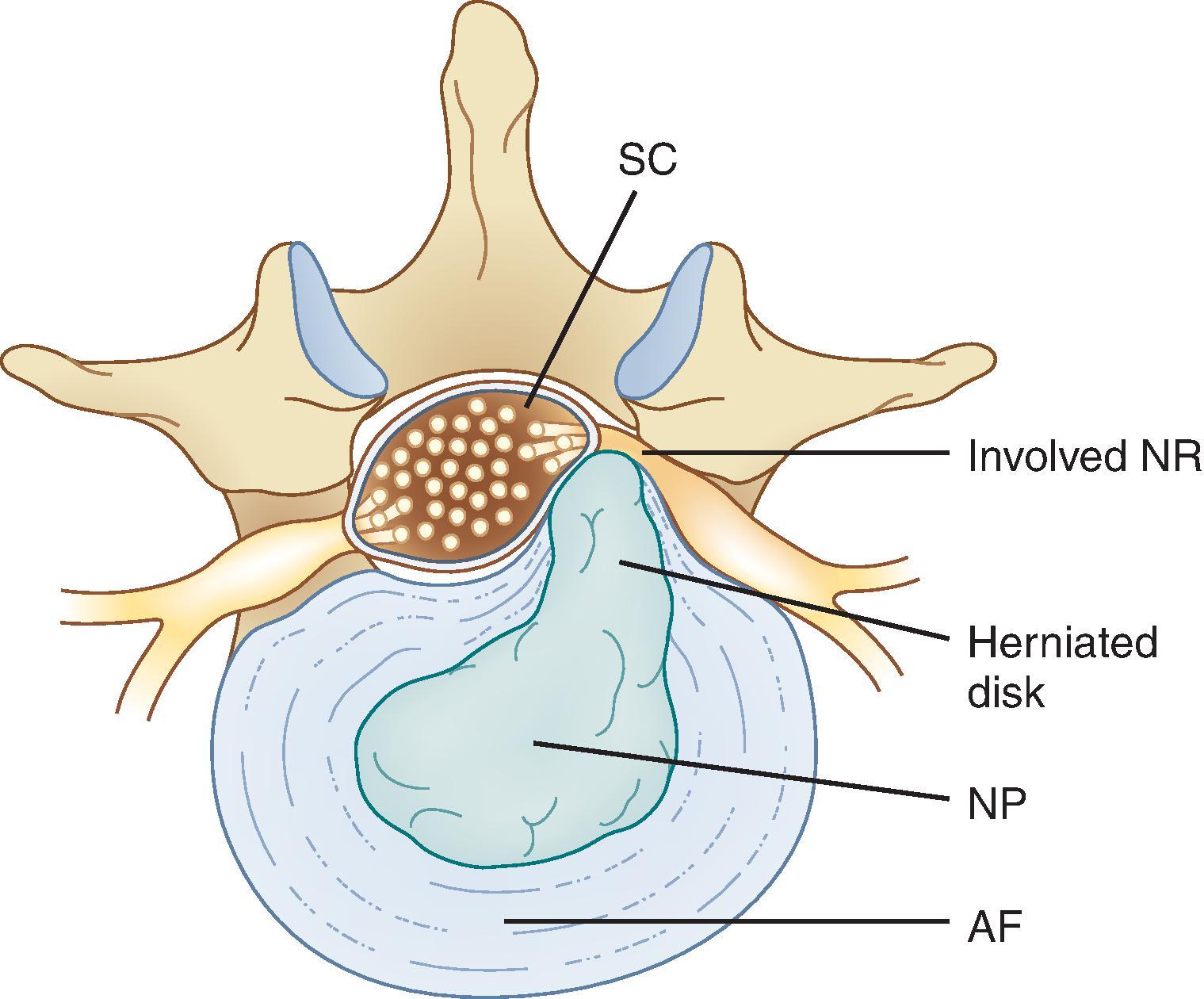
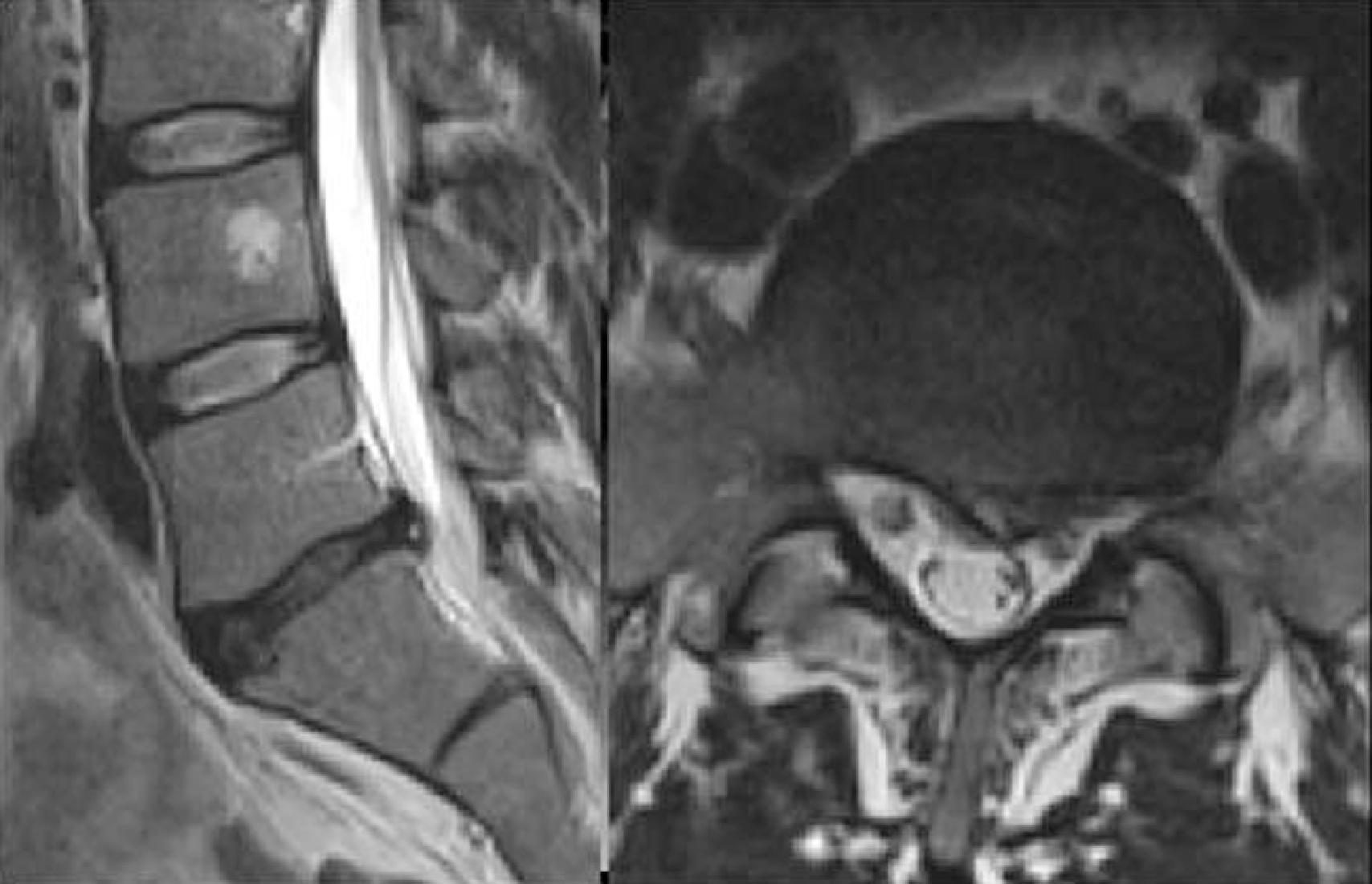
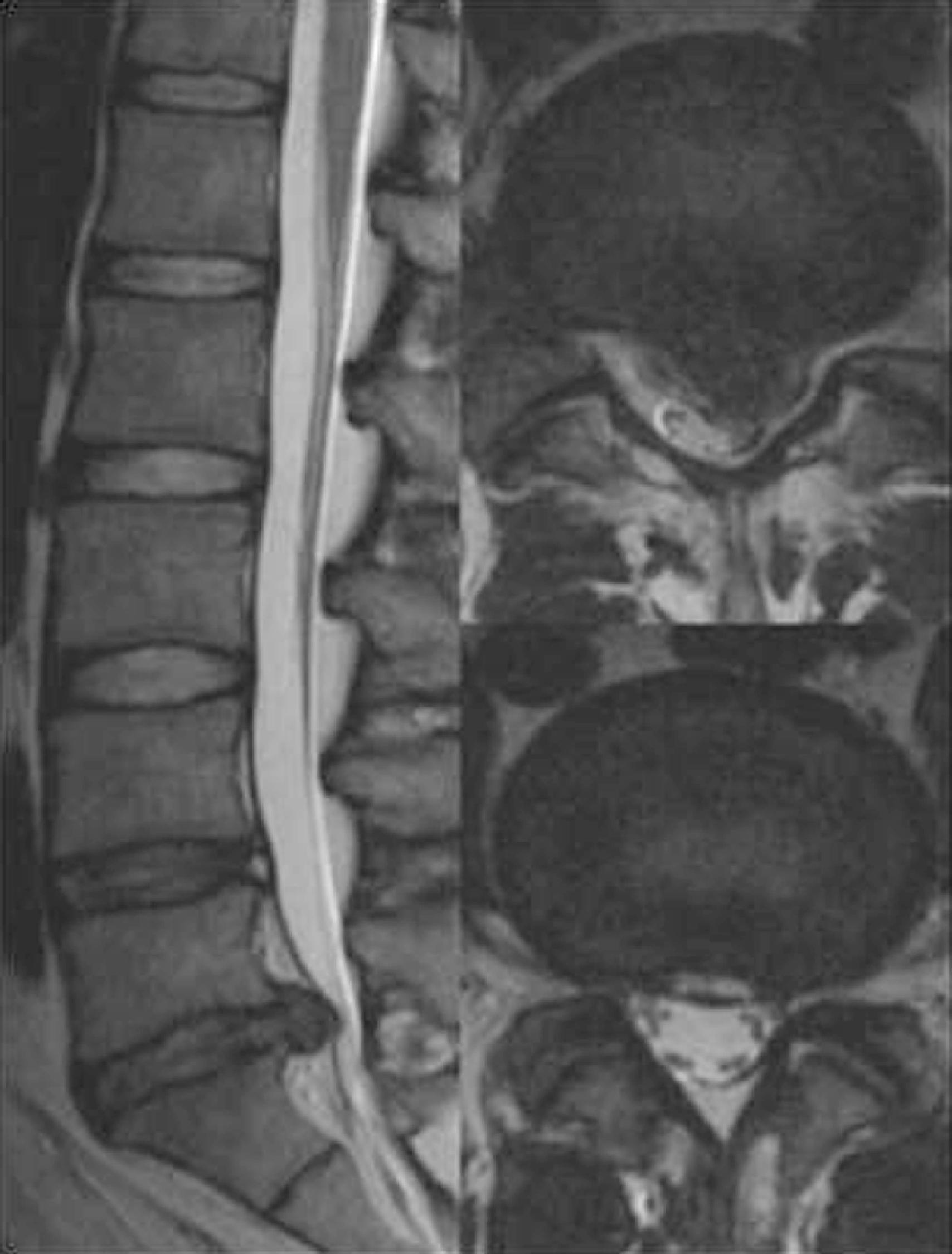
Since Mixter and Barr first reported alleviation of radicular symptoms after removal of herniated disc material in 1934, HD is thought to be the most common cause of LRS. Data from animal studies indicate that NR compression impairs nutrition and can cause ischemic injury, , and deformation of the affected NR by HD fragments are often evident on diagnostic imaging studies in human patients with radicular symptoms. Therefore mechanical compression of the NRs by the herniated disc material (see Fig. 29.2 ) has been commonly acknowledged as the preeminent source of LRS. However, clinical studies have shown that NRs exposed to mechanical deformation and HD material for prolonged periods produced pain while similar NR deformation without exposure to HD material caused no pain. Furthermore, HD material retrieved from patients at the time of discectomy has demonstrated the presence of inflammatory mediators, , and in animal models, the application of the NP, and not the epidural fat, to the NR produced physiologic and anatomic evidence of radiculopathy. The presence of clinical and electromyographic evidence of LRS has also been demonstrated in patients with normal findings and no pressure effects on spinal imaging. Taken together, these observations suggest that inflammatory mediators and inflammation rather than mechanical compression play a central role in LRS because of HD.
The natural history of HD is favorable, and most patients (over 60%) experience significant improvement in their symptoms within the first few months. However, a substantial minority (between 20% to 30%) will fail to improve. Clinical improvement is usually accompanied by resolution of HD on spinal imaging. Large extruded discs decrease in size more rapidly and with greater frequency than smaller disc protrusions and bulges. Physiologic regression of the HD is thought to be via phagocytic processing by macrophages, which are more prevalent in the outermost layers of HD material. Therefore the paradox of larger herniations diminishing more rapidly can be explained by the greater surface area available for phagocytosis in a large extruded disc.
Most lumbar disc herniations occur at the lower lumbar levels, with the L4/5-disc level being the most common (59%), followed by the L5/S1 (30%) and L3/4 (9%) disc levels. Herniation at these levels produces typical radicular signs and symptoms in the affected dermatomes, while centrally HDs may primarily cause LBP with both being exacerbated by SLR. Large, often central, disc herniations can cause neurologic compromise and cauda equina syndrome (CES).
CES is caused by compression, typically acute compression, of the spinal NRs comprising the cauda equina in the lumbosacral spine. The overall incidence of CES is low, affecting approximately 4/10,000 patients with LBP. CES is most frequently caused by a massive midline disc herniation, , or smaller disc herniation in a previously stenotic spine. , Rare causes of CES include spinal metastases, hematoma, epidural abscess, traumatic compression, acute transverse myelitis, and abdominal aortic dissection. Almost 70% of patients with CES also have a history of chronic LBP, but CES is the primary complaint in the remaining 30% of the affected population. These patients, typically seen within 24 h of the onset of their symptoms ( Box 29.2 ), usually present with bilateral but often asymmetric lumbar radicular pain (LRP) and less frequently with LBP. The pain is often accompanied by weakness in both feet, gait disturbances (secondary to pain and weakness), abdominal discomfort (because of urinary retention), urinary overflow incontinence, or bowel incontinence. Objective signs include motor and sensory deficits, diminished reflexes, and positive SLR test, often present in lower extremities. Symptoms of particular significance are diminished sensation in the buttocks and perineum (saddle anesthesia), diminished sphincter tone, and evidence of urinary bladder retention on examination. In approximately 10% of patients with signs and symptoms suggestive of CES, the cause is compression of the spinal cord at more superior levels, i.e. at the thoracic or even the cervical spinal cord. These patients have weakness of the lower extremities, similar to lesions at lower spinal levels, but experience higher levels of sensory loss, corresponding to the level of spinal cord involvement, and may have increased tone and reflexes in the lower extremities. MRI is the “gold standard” for diagnosis of CES, and imaging of the entire spine (lumbar, thoracic, and cervical) is often performed because of the possibility of spinal cord compression at higher levels. , Once the diagnosis is made, treatment involves high dose intravenous steroids and urgent decompressive surgery to reduce permanent neurologic injury and resulting disability.
Features in the Clinical History
Radicular pain in both lower extremities; pain in one leg may be greater
Isolated low back pain is rare
Complaint of weakness in one or both legs and feet
Gait disturbances because of pain and weakness
Abdominal discomfort as a result of urinary retention
Features in the Clinical Examination
Motor and sensory deficits in the lower extremities
Diminished lower extremity reflexes
Positive straight-leg raise and crossed straight-leg raise tests
Saddle anesthesia
Diminished sphincter tone
Evidence of urinary bladder retention
Because of the favorable natural history, herniated discs are typically managed expectantly with symptomatic treatment in the absence of neurologic deficits. , Other specific treatments for HD include a variety of injections and minimally invasive or larger-scale surgical interventions.
Epidural steroid injections (ESIs) have been used to treat HDs for more than 50 years. Traditionally, a posterior interlaminar (IL-ESI) approach is used, and the injectate reaches the anterior portion of the spinal canal near the HD by flowing through the circumferential epidural space around the thecal sac. Transforaminal epidural steroid injections (TF-ESIs) have the theoretical advantage of delivering the injectate directly to the anterior epidural space. Fluoroscopic guidance can improve the precision with which the injectate is deposited in the epidural space. The literature is replete with case series and uncontrolled studies, both in support of and against the efficacy of ESIs. However, a review of the randomized controlled trials (RCTs) of IL-ESI for LRP show ESIs to be more beneficial than control treatments, particularly in the short term, and TF-ESIs were found to be superior to IL-ESIs. , ESIs are discussed in detail in Chapter 65.
Predictors of Outcome with Expectant and Non-invasive Treatments for HD: Predictors of a favorable outcome from conservative treatments include 1) a negative X-SLR test; 2) absence of leg pain with spine extension; 3) absence of degenerative disc changes on spinal imaging; 4) favorable response to ESIs; 5) resolution of any neurologic deficits within 12 weeks; 6) a motivated, otherwise healthy patient; 7) more than 12 years of education; 8) absence of workers’ compensation claims, and 9) absence of comorbid psychologic disorder ( Box. 29.3 ).
Negative crossed straight-leg raise test
Absence of leg pain on extension of the spine
Return of neurologic function within 12 weeks of onset
Absence of stenosis on spine imaging
Favorable response to epidural steroid injections
Patient with 12 years of education
Motivated and otherwise healthy patient
Absence of comorbid psychologic condition
Absence of workers’ compensation claim
Percutaneous disc decompression (PDD) was developed following the success of intradiscal injection of chymopapain for LRP from an HD. Positive results of the intradiscal chymopapain injections suggested that the dissolution of non-herniated intranuclear disc contents may resolve the HD symptoms without directly targeting the HD material ( Fig. 29.5 ). However, chymopapain injections are rarely performed in the United States because of the complications of unintentional injection of this substance into the subarachnoid space and the rare occurrence of severe allergic reactions. During PDD, non-herniated NP tissue is removed, which is postulated to reduce intradiscal pressure that allows inward collapse of the HD fragment. This therapeutic intervention is likely effective in the presence of an intact AF, i.e. when the herniation is assumed to be contained, presumably when the HD fragment is smaller than 4 mm. Based on the principles of joint endoscopy, PDD was initially conducted by using large-bore endoscopes, 7 mm or greater in internal diameter, which were used to remove the NP material. However, these early endoscopes were cumbersome to operate and had the added risk of trauma to the disc annulus and, hence, were quickly abandoned. The technique of automated percutaneous lumbar discectomy (APLD) used a smaller introducer cannula (2.5 mm in internal diameter), and the nuclear material was removed with a suction and cutting technique. Later, a variety of lasers were used to vaporize the nuclear material. These laser disc decompression devices had smaller cannulas, less than 3 mm in internal diameter, and often included a fiberoptic channel for observation. The technique of disc Nucleoplasty® used a smaller (1.5 mm, 17 gauge) introducer needle and bipolar radiofrequency (RF) energy to create small channels, removing the nuclear material. A percutaneous discectomy technique with the proprietary name of DeKompressor® uses 1.5 and 1.0 mm (19 gauge) outer cannulas and a probe that rotates to remove the disc material. A modified intradiscal electrothermal therapy (IDET) catheter (Acutherm®) aimed to induce localized thermal lesioning and shrinkage at the base of the HD material.
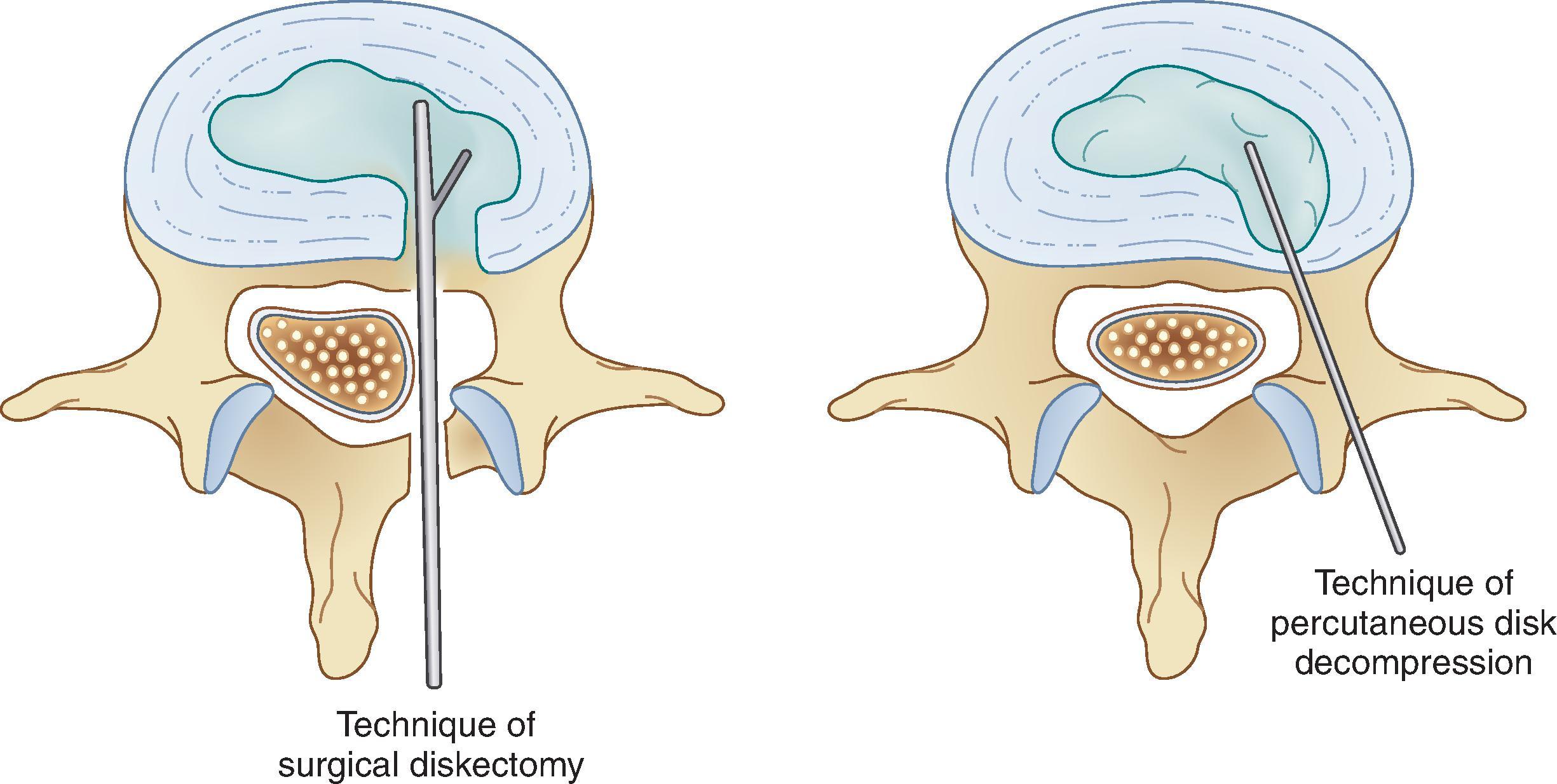
Despite its use spanning several decades, evidence supporting the use of the various PDD techniques is lacking. In one study, MRI of patients before and after APLD showed no difference in the size of HDs at six weeks. Although animal and cadaver studies have shown a reduction in disc pressure after PDD. No evidence exists of high intradiscal pressure in patients with HDs, or its reduction after PDD procedures. Furthermore, the amount of nuclear material removed is variable for the various PDD techniques, ranging from 4 to 5 gm for APLD, 1 gm for Nucleoplasty® and DeKompressor® devices, variable for the various laser procedures, and unknown for the Acutherm® device. Removing large amounts of disc material has been linked to disc collapse and accelerated disc degeneration. However, studies correlating disc pressure and outcomes with a specific amount of nuclear material removed suggest that the optimum amount of disc material that should be removed is unknown. Therefore it may be prudent to remove the least amount of disc material possible to achieve the most beneficial results. Similarly, the use of smaller-gauge introducer cannulas would limit the annular damage and should be preferentially used. Removing nuclear contents from within the disc protrusion itself via a more lateral percutaneous approach has also been suggested. Discography followed by a post-discography CT scan to assess the size and location of the HD and the integrity of the disc annulus has also been proposed prior to the PDD. This practice has been linked to improved outcomes. Two RCTs of APLD showed success rates of 29% and 33%. However, no such trials support the use of laser disk decompression, Nucleoplasty®, DeKompressor®, and Acutherm®, and their use remains anecdotal.
A detailed discussion of the various surgical procedures for HD is beyond the scope of this chapter. Classic discectomy, first popularized by Mixter and Barr in 1934, is the most popular procedure performed for HD. This technique fundamentally includes laminectomy and release of ligamentum flavum to access the epidural space, removal of the HD fragment, and annulotomy to remove the non-herniated disc material (see Fig. 29.5 ). Several variations of this technique exist, which differ in the extent of laminectomy and ligamentum flavum release and annulotomy performed during the procedure. The micro-discectomy procedure is less invasive and aims to minimize the surgical trauma and limit the potential for NR injury and epidural scarring. Although surgery is commonly performed for HD, little high-quality evidence exists in its support. A prospective trial comparing surgical and non-surgical treatments for HD showed superior outcomes in surgically treated (92%) than the nonsurgically treated patients (61%) at one year. However, these results deteriorated over time, with differences between the groups becoming less significant at four years and insignificant at ten years. This study was also criticized for lacking careful randomization and blinding, a large crossover of patients to the surgical group, insensitive outcome measures, and small sample size. Another frequently cited study in support of operative treatments is a non-randomized and observational study with similar results at one and five years but slightly favorable results for surgical treatment at ten years (56% vs. 40%, P = 0.006). The spine patient outcomes research trial (SPORT) showed primary outcomes to be in favor of surgery at all observation periods. However, these differences were not statistically significant, and the main benefit of the surgery was the faster resolution of pain. It appears that the main reason to undergo surgery is the urgency with which a patient wishes to achieve pain relief over the following two to four months. However, the need for surgery is absolute in patients with CES, and surgical treatment is generally necessary for patients with progressive motor deficits. In contrast, other indications for surgery, including intractable pain and poor response to conservative therapy, appear relative. The results of micro-discectomy have been reported to be superior to those of traditional discectomy. Although patients with “sciatica” of more than 12 months duration have been shown to have less favorable results after surgery, the full effects of a potential delay in operative treatment, while nonsurgical treatment is attempted, remain unknown. Overall, the lack of consensus and variability of adherence to indications for surgery is demonstrated by the nearly 20 fold difference in surgery rates in otherwise demographically similar United States populations.
Become a Clinical Tree membership for Full access and enjoy Unlimited articles
If you are a member. Log in here